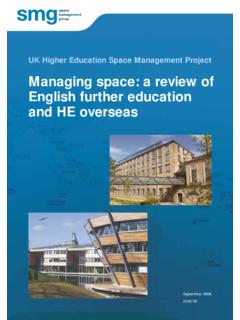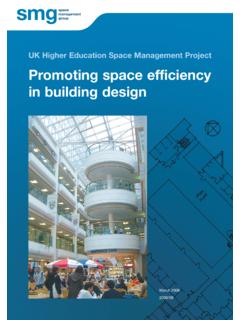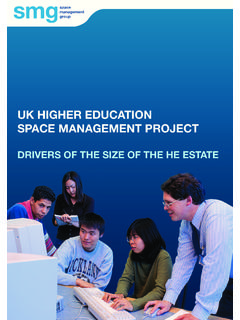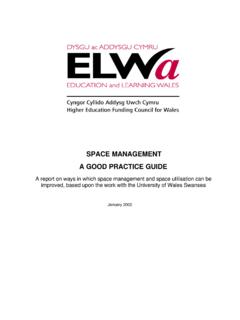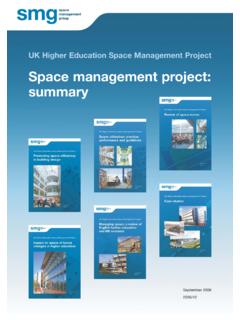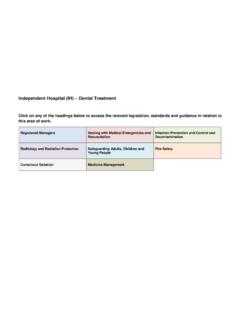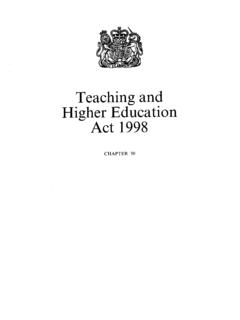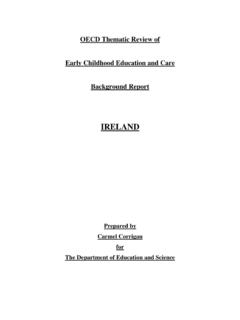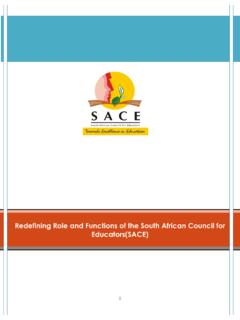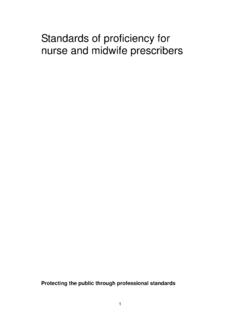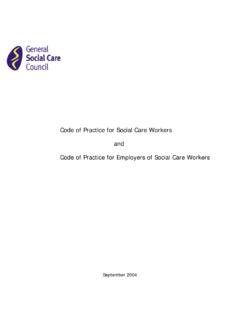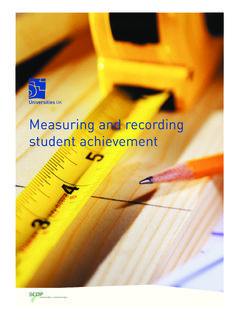Transcription of Space utilisation: practice, performance and guidelines - …
1 UK Higher education Space Management ProjectSpace utilisation : practice, performance and guidelinesSeptember 20062006/38 Two of the front cover images, of the Jewellery School (top right) and the Library (bottom)are courtesy of UCE utilisation : practice, performance andguidelinesContentsPageExecutive summary31 Introduction52 Practice and performance73 Reasons for low utilisation134 The strategic role of utilisation165 guidelines for a strategic approach to utilisation23 Bibliography26 Annex 1: Review of earlier utilisation guidance27 Space utilisation : practice, performance and guidelines 2006/38 1 Executive summaryScope of the studyThis study was commissioned by the UK HigherEducation Space Management Group (SMG).
2 Itreviews practice and performance in spaceutilisation and develops additional guidelines fortaking a strategic approach to of utilisationSpace utilisation is a measure of whether andhow Space is being used. The utilisation rate is afunction of a frequency rate and an occupancyrate. The frequency rate measures the proportionof time that Space is used compared to itsavailability, and the occupancy rate measureshow full the Space is compared to its rates can be assessed in terms of bothactual use and predicted use. Strategic roleSpace utilisation is a strategically important spacemanagement measure. Phase one of the SMG swork developed tools to help higher educationinstitutions (HEIs) to assess what size of estate isaffordable.
3 It calculated the cost of having an estatethat is kept fit for purpose and in good condition. Assessments of what is affordable need to belinked to the type and amount of Space that isrequired. utilisation studies provide informationon how Space is being used and help to informdecisions about the type and scale of facilitiesneeded. They raise questions about the mosteffective use of resources. If Space is not beingused, is it needed and does it need to be funded?Could the resources consumed by under-usedspace be better directed elsewhere?Current performanceMost HEIs collect some data on utilisation . Themain focus is on teaching Space . The EstateManagement Statistics (EMS) project reports datafor the sector on the utilisation of teaching for 2003-041show that the medianreported utilisation rate was 27 per cent over acore teaching week.
4 Out of the total availabletime, rooms were reported as being used for justover half the time, and when they were used, theywere found to be just under half full. Nearlythree-quarters of the available teachingworkplace/hours were not in use across the HEIs have objectives and targets forincreasing utilisation , there has been relativelylittle change in sector-wide rates in recent are many factors which operateindependently or in combination to depressutilisation. One of these is a marked differencebetween predicted and surveyed rates ofutilisation. Other factors include teaching andlearning trends, whether or not detailedinformation is available on what Space is needed,and the nature of the estate in terms of its fitnessfor purpose and costs and benefitsDespite these challenges, it is important tooptimise utilisation .
5 There is a balance betweenminimising cost and meeting the pedagogical andresearch needs of staff and the learning andsupport needs of students. This balance will varybetween HEIs, but when decisions are madeabout what is the optimum level, it is advisableto be aware of the opportunity costs of lowutilisation. Effective utilisation of Space alsocreates a good match between Space needs andspace provision, and helps to improve the staffand student opportunity costA tool called the inefficiency multiplier can beused to give insight into the opportunity inefficiency multiplier describes the amountof Space being provided at a given level ofutilisation for every m2in use. At the EMSreported rate of 27 per cent in the data for 2003-04, m2is being provided for 1 m2beingused.
6 The higher the rate of utilisation , the lessspace that is being provided; the lower the rate,the greater the Space being provided for every m2in use. As a corollary, a low level of utilisationwill lead to a high cost of Space to support agiven activity, and a low ratio of income per utilisation : practice, performance and guidelines 2006/38 31 References to data for 2003-04 in this report are from the EMS institutional report targeting of very low levels ofutilisation can have a major impact on , because of the non-linear relationshipbetween utilisation rates and Space provision,where utilisation is very low, a small increase canhave a significant impact on the amount of spaceprovided and on the attendant cost.
7 guidelines for a strategic approach toutilisationThe guidelines contained in this report are notintended to supersede existing good practiceadvice. They aim to extend that guidance toassist HEIs in taking a strategic approach utilisation levels to rise significantly thereneeds to be either an increase in activity and/or adecrease in the amount of Space . In the absenceof either, the effects of the inefficiency multiplierand the Space costs carried by HEIs will beunchanged. The links to the overall estatestrategy for HEIs and to the assessment of theaffordable estate are essential drivers foroptimising utilisation guidelines discuss ways of collecting therelevant data on both predicted and actualutilisation; evaluating current performance andthe reasons for it; calculating the inefficiencymultiplier; reviewing targets; and developingmeasures to optimise utilisation .
8 They highlightthe benefits of: extending assessments beyond teachingspace to look at the use of different types ofHE Space linking utilisation to the SMG tools ofbenchmarking the size of estate andcalculating what is affordable for individualHEIs using the inefficiency multiplier to analyseexisting utilisation and set utilisation targetsfor the level at which HEIs wish to operate using the inefficiency multiplier to focus onbuildings or types of Space with particularlylow levels of utilisation and assessing theopportunity costs linking targets for different types of Space tooptimisation of predicted uses building the results into the estate strategywith the aim of delivering the appropriateand affordable size
9 Of estate securing top-level support within HEIs foroptimising utilisation and for measuresdesigned to effect institutional utilisation : practice, performance and guidelines 2006/381 The Space Management ProjectThe brief for this study was to review spaceutilisation practice and performance and toconsider the scope for updating guidance onutilisation for higher education institutions(HEIs). It has been prepared by Kilner study is part of phase two of the SpaceManagement Project (SMP). The project is underthe direction of the UK Higher education SpaceManagement Group (SMG), supported by thefour UK funding bodies for higher education , theHigher education Funding Council for England(HEFCE), the Scottish Funding Council (SFC),the Higher education Funding Council for Wales(HEFCW) and the Department for Learning andEmployment (in Northern Ireland), Scope of the reportThis report sets out the results of the research.
10 Itcovers the following: how Space utilisation is usually defined inhigher education the reasons for revisiting it as part of the SMP performance and practice in the sector reasons why utilisation rates may be lowand difficult to raise the strategic importance of Space utilisation guidelines for a strategic approach What is Space utilisation in highereducation?In higher education (HE) in the UK, spaceutilisation is usually defined as a measure of howrooms and spaces are being used both in termsof how often rooms are used and, when they are inuse, how many people are in them. The NationalAudit Office s (NAO) Space Management inHigher education : A Good Practice Guide (1996)sets out the standard calculation:% frequency x % occupancy100 Where: Frequency is the number of hours a room is in use as a proportion of total availability (thetimetabled week) Occupancy is the average group size as a proportion of total capacity for the hours a room is in utilisation .
